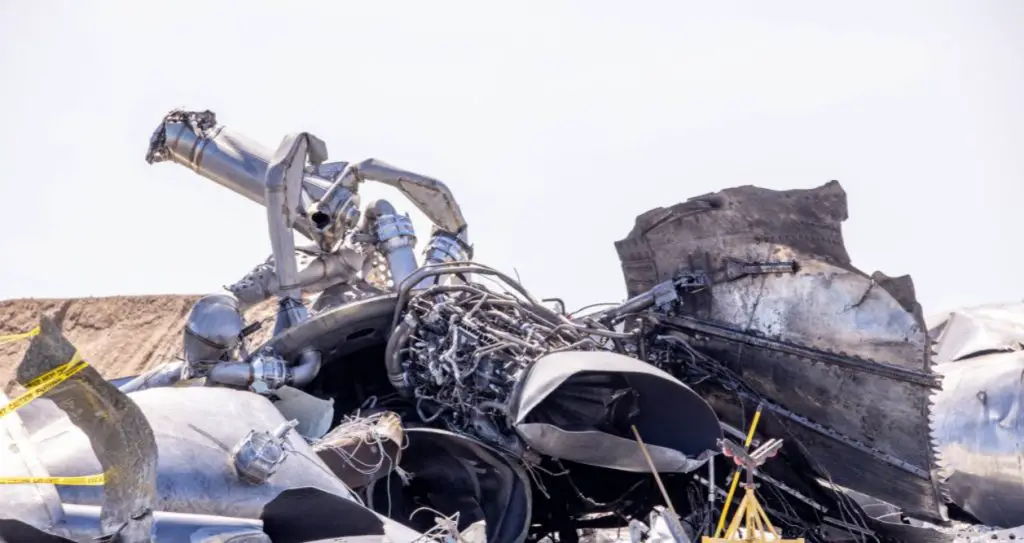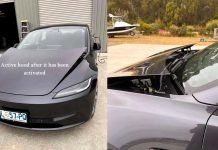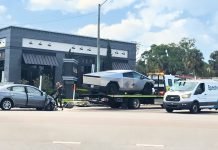SpaceX is currently carrying out tests on its Starship rocket using the Super Heavy booster. They tested the Serial Number 8 prototype (SN8) in December, and SN9 in February. The test description was actually simple – lift-off and climb to around 10 km above the ground, then plummet to the earth’s surface in belly-flop position and re-fire engines to make a vertical landing. SN8 and SN9 had both failed in the final step, slamming into the ground and exploding immediately.
A few days ago, SpaceX tested the SN10 for a similar procedure. The test gave better results than its predecessors. It managed to re-fire its engines and landed on the pre-determined position softly. However, a few minutes later, it caught fire at the base and exploded immediately. While the staff was seen investigating the wreckage, fans and reporters also spotted a yellow-coloured robot dog.
The four-legged robot is a Boston Dynamics robo-dog “Spot”, which SpaceX has renamed as Zeus. Many people have spotted this robot dog on SpaceX landing sites before, although SpaceX hasn’t commented on its functionalities yet. Most sources say that it is fitted with cameras and sensors in order to collect images and other data from wreckage sites.
The SN10 Landing Incident
SpaceX has been testing out the Super Heavy rocket for its future missions. To fulfil Elon Musk’s long list of ambitions for his aerospace company, the reusability of rockets is the major hurdle. According to reports, the mission-wise expenditure can reduce by a thousandfold if SpaceX is able to completely reuse its rockets from earlier launches. This makes the successful landing of these rockets a foundational step.
For the past year or so, testing has been at a fast pace at SpaceX. The successful launch and landing of the Super Heavy is a crucial step in Musk’s future plans, and SN10 has brought them a lot closer.
The test saw SpaceX launch the SN10 up to a height of 10 km above the ground. It then carried out a few manoeuvres in the air, before starting the return journey. Return ‘journey’ is an overstatement, as it simply plummeted in belly-flop position, guided by four wing flaps. The test seemed successful after the rocket re-fired its engines and got into an upright position before landing softly onto the launch pad. However, around eight minutes later, the base of the rocket caught fire and it exploded instantly.
While the test may seem unsuccessful at first glance, the fact that the SN10 re-fired its engines and managed to land in a vertical position is a big step. Elon Musk took to Twitter to report the initially-successful test, before updating the status after the explosion. He praised the SpaceX team for its latest progressive step.
The Spotting Of ‘Zeus’
After the smoke had cleared and roads reopened, spectators and reporters flocked the wreckage site. There were two crews working on the site, one for debris clean-up and one for wreckage inspection. It was then that people spotted the four-legged Zeus.
Spot!! pic.twitter.com/mkvqoQ2jEg
— SPadre (@SpacePadreIsle) March 4, 2021
Zeus was inspecting the different parts of the wreckage site, possibly checking for hazards before the crew got there. It was walking through nitrogen smog as it set about capturing any evidence for potential dangers. The robodog was designed by Boston Dynamics but is owned by Hyundai and first appeared during SpaceX’s prototype test of SN7 in June 2020.
#SpaceX inspecting their #Starship SN7 tank prototype after a successful test-to-failure cryogenic test with their #BostonDynamics Spot robot dog called "Zeus"
?by @LabPadre pic.twitter.com/q15WxWlg45
— xape (@tiefseeudo) June 23, 2020
The robot cost SpaceX around $75,000 and can roam around indoors as well as outdoors. It can map and sense the environment, climb stairs, open doors and avoid obstacles. SpaceX has made some (quite expensive) modifications to Zeus, which includes LiDAR, sensors and camera mounts. These modifications cost SpaceX around $100,000. There were some more posts about Zeus.
Zeus in action! A quick video I was able to capture of SpaceX's robotic @BostonDynamics dog walking around the launch site ??
? -Myself for @SpaceflightIns pic.twitter.com/v5a6GvOBZ6— NickyX ?? (@NickyX15A) March 3, 2021
Many people compared the incident to an episode of Black Mirror, which is a futuristic sci-fi TV show. The show featured a similar robotic dog named Metalhead.
SpaceX’s Future Plans
The SN10 is a step forward for SpaceX from a reusability perspective. However, they still need to work on eliminating these explosions, as it is tough to reuse parts after even a small explosion. The SN10 saw its Raptor engine tear apart, sending remains flying across the site. The mangled remains of the engine can be seen in the image below.

The engine cost SpaceX $1 million and also evaporated any hopes of using parts of this rocket in further missions. Of course, the crew kept working on the site, looking for any parts that are reusable.
Crews are now cutting apart the remains of SN10. No time to waste. Bring on SN11. pic.twitter.com/Z1TiRXKVit
— Dayton Costlow (@DaytonCostlow) March 4, 2021
Reusability is the USP of SpaceX rockets. Elon Musk started this company with the hope of drastically reducing the manufacturing costs of rockets by reusing as many parts as possible. While they have worked on recovering the payload fairings of the rockets in the past, having an entire land safely back on Earth can make a huge difference.
Make no mistake, what SpaceX achieved with the SN10 is incredible. Now, they need to work out the problems leading to these explosions. One can definitely say though, that the aerospace industry is getting a lot of boost due to SpaceX.


















